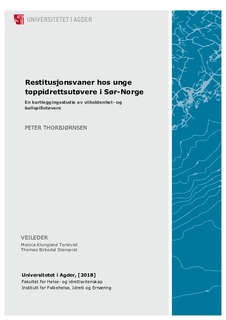| dc.description.abstract | Background: In order to perform optimally in training and competition, the recovery inbetween,
through adequate diet and sufficient sleep/rest, is of great importance. Up until now,
most studies have only featured adult athletes. Similarly, studies conducted on young athletes,
as well as across sports, are limited.
Purpose: The purpose of this study was to assess the habits of recovery, in terms of diet and
sleep, with regards to the recommendations given by Helsedirektoratet and Olympiatoppen.
Further investigating the use of different recovery strategies, among young elite athletes in
southern Norway.
Method: A total of 36 young elite-athletes (24 endurance-, 12 ball-game athletes) participated
in the study. Dietary registration was conducted through a seven-days semi-structured recallinterview.
The participants' activity level and sleep was measured for the corresponding days.
To describe the selection, anthropometric tests, a questionnaire, health and performance tests,
were conducted.
Results: Protein intake, meal frequency and energy availability, were adequate according to
the recommendations, although endurance athletes had a somewhat high fat intake.
Recommended carbohydrate intake was met for moderate exercise (5-7g/kg/day), however
too low for high intensive exercise (6-10g/kg/day). The amount of sleep was recorded as
somewhat insufficient, in regard to the recommendations (8-10 hours). No differences were
observed across sport groups. Only stretching was used regularly as a recovery strategy.
Conclusion: Young elite-athletes in southern Norway generally had a satisfactory diet and
meal frequency. However, the carbohydrate intake was in the lower span, the fat intake was
too high, and the amount of sleep was somewhat insufficient compared to the
recommendations at hand. Further research should investigate whether diet- and sleep
optimization can lead to better recovery for young elite athletes.
Key words: Sports nutrition, elite athletes, recovery, adolescent, sleep, endurance athletes,
ball athletes | nb_NO |

